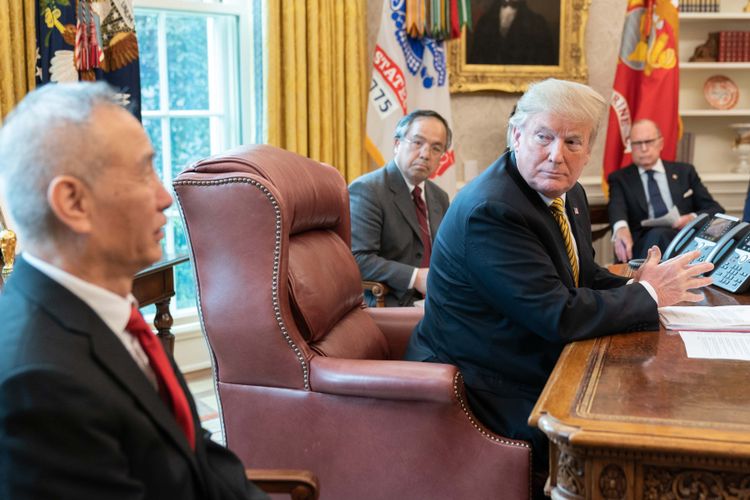ART WORLD NEWS
Trump delays tariffs on Chinese goods until December—but not for art and antiquities
[ad_1]
President Trump meets with the Chinese Vice Premier Liu He at the White House following continued US–China trade talks earlier this year
Courtesy of the White House. Photo by Shealah Craighead
Christmas came early for some as Donald Trump delayed new tariffs on Chinese goods until mid-December in order to buoy holiday sales on consumer products. It is “bah humbug” for the art trade, however—a new 10% tariff on art, antiques and antiquities will take effect 1 September, continuing the ongoing trade war between the US and China.
Although the US president’s announcement offered a welcome reprieve from the escalating tensions between the two countries, around half of the proposed $300bn worth of goods will still be subject to tariffs within weeks under the revised list of items published yesterday by the United States Trade Representative (USTR). Among them are many collectibles, including paintings, drawings, engraving, prints and lithographs, sculptures and statuary of any material and antiquities more than 100 years old, as well as stamps and collectors’ pieces of archaeological interest.
“The US import tariff will apply to all Chinese art sourced anywhere in the world, not simply Chinese art imported from China. [It] will act as a tax on all US collectors, curators and dealers buying anywhere on the international market,” says the New York-based dealer James Lally. He specialises in Chinese art and antiquities and has lobbied vociferously against the inclusion of these items on the 10% tariff list since they were proposed—and then removed—from the items list last year.
Whether art and antiquities would remain subject to Trump’s tariffs has weighed on many dealers and auction houses since June, when they were re-added to the USTR’s list of goods subject to a sizeable 25% tariff rate. Throughout the summer, art and antiquities dealers, as well as numerous cultural advocacy groups, beseeched the USTR to remove the items from consideration in a series of hearings held on Capitol Hill. They argued that such border taxation would represent a significant departure from longstanding US government policy to encourage the free exchange of cultural goods by making their import duty free.
“I expect this will cause US residents to be more selective and less active on the international market,” Lally says. “The US import tariff will also add complications and costs for any dealer [in Chinese art] outside the US interested in participating in a US art fair or auction.”
“Today’s decision will hurt small businesses and the art trade between the US and our allies in the UK and Japan more than it will hurt trade with China which already bars exports of most Chinese antiques and antiquities,” says Peter Tompa, a lawyer at the Washington, DC-based law firm Bailey & Ehrenberg and the executive director of the Global Heritage Alliance.
While there is still an opportunity for dealers to seek specific exemptions, such requests may be difficult to formulate and pose both a financial and administrative burden. “With the tariffs in place, it will be impossible for these businesses to price artwork competitively within the global art market. The tariffs will also stifle the greater cultural exchange that galleries foster,” the Art Dealers Association of America says in a statement to The Art Newspaper.
Indeed, dealers have already been feeling the tariff throttle even before they have gone into effect. Last month, Pace Gallery closed its mainland China outpost after a decade in its space in Beijing’s 798 art district, citing the US-Chine trade war as a pain point. “The last straw is Trump’s duty on Chinese art coming into this country and Xi Jinping’s duty on American art coming into China,” founder Arne Glimcher told Artnews.
The administrative burden imposed by the tariffs will be sizeable. Essentially, each collector, curator or art dealer will have to decide what to do on a “case-by-case, item-by-item basis”, according to Lally. He is quick to add, however, that dealers will not be the only ones affected. International auction houses operating in the US will be likely to advise non-US sellers not to send their Chinese art to New York for sale, and US residents may not wish to send Chinese art to sale at auctions outside the US because unsold lots would be subject to the tariff upon return to the US.
“There is not an easy remedy to alleviate the confusion, complications and additional costs this US import tariff will cause,” Lally says.
[ad_2]
Source link













